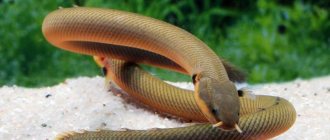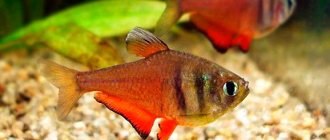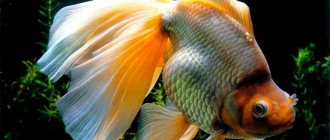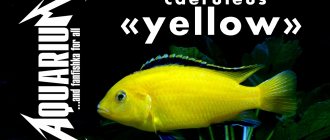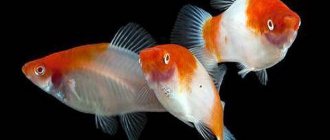The snakehead is an aquarium resident for exotic lovers. The fish, vaguely resembling a snake, is an aggressive predator. But this is only one side of the coin. Snakeheads are beautiful, large, with special habits. It is always interesting to watch such inhabitants of home aquariums. Some snakeheads grow too large and are considered unsuitable for keeping at home, while others are quite accessible to experienced aquarists.
Kinds
- The imperial snakehead is the largest representative of the species, growing up to 60 cm. It does not tolerate neighbors. Color – dark above, light below, with a clear contrasting transition. The eyes are red. Rarely kept in aquariums due to its large size;
- The ocellated snakehead is a beautiful large predator. The body is slightly compressed from the sides, which makes it look like ordinary fish. Its main name is three-spot snakehead. It got its name “ocellitose” due to a number of large black spots framed on its side. The main color is grey-silver. The size is 45 cm, so the fish is kept only in huge aquariums;
- The dwarf snakehead is the most popular among aquarists due to its size. Rarely grows more than 15 cm. Relatively easy-going: does not bother those larger than it, as well as relatives. It can even be kept in a small flock. Aggression manifests itself during the spawning period, so a pair ready for mating must be placed in another aquarium, or all other inhabitants must be removed;
- The red Chinese snakehead is considered the most aggressive towards its neighbors. Aggression especially increases in closed aquarium conditions. However, even in nature, the red snakehead actively hunts and keeps everyone around it, including its own kind, in fear. Dimensions – 15-20 cm;
- The rainbow snakehead is another aggressor. The body shape of the fish resembles an arowana: elongated, with a wide-opening lower jaw. Dimensions - 15-20 cm. Categorically does not tolerate neighbors unless they are snakeheads. Tolerant of relatives. You need a spacious aquarium with shaded areas: plenty of foliage, location of the aquarium in the shade, etc.;
- Stuart's snakehead - grows up to 20 cm, but is timid. The snout is somewhat rounded compared to other snakeheads. In the aquarium it leads a closed lifestyle: it hides in shelters. Body color is turquoise, with darkened rays on the fins;
- The brown snakehead is a fish native to southern India. It grows up to 40 cm, adults have a rich brown color with lighter fins. Edible and a popular fishing object. Its second name is the red-striped snakehead; in young individuals a red stripe along the body is visible;
- The golden cobra snakehead is a serious danger for most fish: it itself reaches a size of 40 cm, and willingly eats everything that fits into its huge mouth. In addition, the snake-like fish is very mobile and resourceful. But very beautiful: the color consists of a combination of blue and yellow;
- Pulchera snakehead - maximum size 30 cm. Aggressive towards neighbors, gets along with its own kind. The color is dark blue, the fins are contrastingly spotted black and white. Small golden oblong spots are scattered throughout the body.
Characteristic
This freshwater hunter with sharp teeth received such an unusual name due to the similarity of the shape of its head to that of a snake. It is not for nothing that one of the species of fish is called the golden cobra snakehead, or Channa aurantimaculata in Latin.
According to scientific classification, all snakeheads belong to the Perciformes family, although some species strongly resemble eels. They are found over a vast territory: from Central Siberia in the north to Indonesia in the south, from Afghanistan in the west to Eastern China (genus Channa).
There is also a separate African subspecies - the genus Parachanna.
Each variety differs not only in its size, but also in color and fin structure.
All snakeheads have the following features in common:
- elongated body
- head like a snake
- but the main thing is the presence of a specific epibranchial organ, which allows fish of this species to breathe atmospheric air.
Yes, snakeheads can go without water for some time, and this quality allows them to naturally crawl from one body of water to another if they are located close to each other.
The peculiarity of the structure of the body means that fish can live peacefully in reservoirs with a low content of oxygen dissolved in water, and at low temperatures and high air humidity, these predators can do without water for up to 3 days!
Snakeheads living in the water bodies of Afghanistan and India, when rivers and irrigation ditches are temporarily drying up, are able to burrow deeply into wet silt, waiting out the dry period for some time.
Most decorative Channas live 8-10 years.
Snakeheads are believed to be intelligent creatures. Over time, they recognize their owners and, in some cases, begin to take food from their hands. But it is not recommended to stroke them - they can bite quite painfully.
How to keep a snakehead
First of all, the snakehead is a large aquarium fish. Therefore, only those who have a spacious aquarium can keep it. At the same time, many snakeheads tolerate oxygen deficiency well. In Southeast Asia, they are successfully bred in irrigation canals. And yet, in order for the fish to be comfortable, you need to create good conditions.
Arrangement of the aquarium
- volume – for dwarf species growing up to 15 cm, it is possible to keep them in a 150-liter aquarium. Larger species require large-scale tanks with a capacity of at least 300 liters per fish. There are also requirements for the shape of the aquarium: it must be not only long, but also wide so that the fish can turn around in it;
- soil – gravel with a fraction of 5-7 mm is suitable, it is easy to care for;
- filtration and aeration are required. Snakehead fish are not clean, so the filter must be selected especially carefully. Aeration is needed to maintain water parameters. The fish themselves breathe mostly atmospheric air, swallowing it from the surface of the water;
- decor – for small species, shelters are desirable: ceramic tubes, pots, jugs, piles of stones. Large species are not pretentious in design, but it is better to arrange caves for them;
- living plants should create shaded areas. Snakeheads do not like bright lighting and prefer dim biotopes. It is better to plant the plants themselves in the ground in separate pots;
- A lid is a must on any aquarium containing snake-like fish. She is nosy, resourceful and extremely jumpy. It can even jump out of a home aquarium during a water change.
Water parameters
- temperature 26-28°C
- hardness 7-15°;
- acidity 5.5-7.5 pH;
Maintenance and care
- cleaning the soil with a siphon once a month (for 150 l aquariums - twice a month);
- weekly change of a small amount of water (about 1/10).
Habitat in nature
In nature, the habitat of snakeheads is wide; they live in the southeastern part of Iran and eastern Afghanistan, China, Java, India, as well as in Africa, in the Chad and Congo rivers.
Also, careless aquarists released snakeheads into the waters of the United States, where they perfectly adapted and began to destroy endemic species. Now there is a stubborn but unsuccessful war with them.
There are two genera (Channa, Parachanna) which include 34 species (31 Channa and 3 Parachanna), although the diversity of snakeheads is high and several species are yet to be classified, such as Channa sp. 'lal cheng' and Channa sp. 'five stripe Kerala' - although they are already on sale.
Behavior and Compatibility
As can be seen from the description, the character of this fish is so aggressive that it can even bite its owner. But, like many large fish, the snakehead is distinguished by intelligence, usually it still gets used to and loves the one who feeds it, and can take food from hands.
In an aquarium, snakefish usually live near the bottom in a shaded area. Floats to the surface of the water to become saturated with oxygen.
As for neighbors, the only rule is that they should not fit into the snakehead’s mouth. Otherwise, sooner or later all the inhabitants will be eaten. The snakehead rarely fights for territory; the main motivation for its aggression is food. Some species cannot even tolerate their own relatives as neighbors.
Dwarf snakeheads can get along with astronotus and other large cichlids; they do not touch the king bots. It is ideal if all the fish are placed in the aquarium at the same time at a young age: this increases the likelihood that they will all live to an old age.
External data
The appearance of snakeheads changes as they grow older. Certain types of fish at a young age have a more colorful color than older individuals. Babies have orange-red or bright yellow stripes along the length of their body. But the older the fish gets, the more it differs from the youth: the color becomes grayer and darker.
Other species, on the contrary, acquire a brighter and more beautiful shade with age.
Therefore, before purchasing a snakehead, you need to familiarize yourself in detail with its color changes as it grows, so as not to be disappointed in the fish later.
The only thing snakeheads have in common is:
- head resembling a snake;
- elongated torso;
- a special organ located above the gills, thanks to which fish can breathe ordinary air.
Breeding
In a flock of several individuals, one pair can form by the age of 4 years. In this case, it is better for the rest to find another home, since the onset of puberty makes the fish more aggressive towards their own kind.
Snakehead breeding process
Spawning at home occurs at a temperature of 27°C. No other special conditions or parameters are required. The female lays eggs on leaves or in a specially constructed nest of bubbles. There are species that hatch eggs in their mouths. After fertilization, the male takes care of the eggs. It is better to remove the female, since he sees even her as a threat to the offspring.
The fry appear on the fifth day maximum. The male protects the babies for about two more weeks, after which it is better to remove them.
Description
The body is cylindrical and elongated. The head is large, slightly flattened on top. The head and body are covered with scales. The mouth is large, the jaws are equipped with sharp teeth. The pectoral, abdominal and caudal fins are round in shape. The dorsal and anal fins are long. Large fish. Some specimens reach more than a meter in length and weigh more than 20 kg.
The red-striped snakehead gets its name from the peculiarity of the coloring of young individuals. The fry has a wide red stripe along its body, bordered by two dark longitudinal lines. With age, the color of the fish darkens, the red stripe becomes dark, brown or almost black. The belly, throat and pelvic fins are light. Lighter spots and lines are often visible on the back. The color is variable and depends on the habitat.
A predatory fish that feeds on invertebrates, amphibians and fish. It attacks prey from ambush. Likes to stay in thickets of algae or near snags. Easily tolerates a lack of oxygen in the reservoir.
Snakehead diseases
In general, fish have excellent immunity. Adults are susceptible to parasites that can appear in an aquarium with untested contaminated food. In very poor living conditions, infectious diseases also occur.
Prevention is simple: fulfilling all maintenance and care requirements, regular water changes, using only clean equipment and quarantine of all new fish entering the aquarium (including those intended for food). Particular attention should be paid to the quality of the feed.
Separately, it is worth saying that snakeheads are sensitive to sudden changes in water parameters. Therefore, it is not recommended to replace too much volume at a time. Frequent changes of small quantities are preferred.
Reviews
The snakehead is interesting to keep due to its non-standard appearance, habits and attachment to the owner. When planning to have this predator in your home aquarium, it is important to understand that the fish has a tremendous reaction and attack speed. She will catch anything she considers food, and her assertive and quarrelsome disposition can cause a lot of problems in a species aquarium.
Would you like to purchase a snakehead for your own aquarium? Share in the comments!
Interesting Facts
- The snakehead has structural features of its respiratory apparatus that allow it to breathe atmospheric oxygen. Therefore, there should be a space of 5-7 cm between the aquarium lid and the surface of the water;
- In addition to decorative keeping, snakeheads are raised for food in special ponds. Commercial species have tasty meat;
- in some countries there is entertainment - sport fishing for snakeheads;
- Some species living close to the equator often experience drying up of water bodies. In this case, the snakehead can either burrow deep into the silt and wait out the drought, or crawl overland into a nearby puddle.
This is interesting
Large species of snakeheads are of commercial importance in some countries; their meat is lean and quite tough. But their rapid growth and extreme unpretentiousness make it possible to successfully breed them in artificial reservoirs, where other fish could not live, feeding on tadpoles and frogs. In South India, snakeheads are bred in special irrigation wells.
If we talk about the price of these fish, it can be very different. New and rare species are especially expensive. Thus, the price of one of the rarest species of snakeheads, Channa barca, at the first moment of its appearance on the market reached 5,000 euros. Since then it has dropped significantly.
Nutrition
All snakeheads are predators, and it is better to feed them with live food: small frogs, small fish, shrimp, earthworms.
The diet can also include pieces of meat, fish fillets, frozen squid, and occasionally dry food. These fish will not touch plant food.
The frequency of feeding for adult fish is 1-2 times a week, and for juveniles - daily.
The feeding feature of these voracious fish is also interesting: they hit living food with their muzzle and stun it, then immediately release all the air through the gills, creating a vacuum in the mouth, and the stunned living creature itself is sucked into the mouth.
Reply to the post “An aquarium for every pick-up guy on the table!”
Well. I got confused. Thank you, comrade @psbspb. Since childhood I wanted some fish for myself. So it's done.
I bought myself an aquarium cube. I bought a filter, a lamp, and primer. Everything according to the instructions.
I collected everything, connected it, poured soil, and leveled it. I also bought a thin hose from a dropper. He began to slowly pour in water.
I poured it for a long time. I managed to get a couple of plants - I don’t remember what they are called correctly - in common parlance - anubises. Sticked them into the ground. I know that it’s supposed to be impossible, they seem to have to cling to the koyaga and the stone, but none of this happened.
The water was still overflowing. He freaked out and just poured it out.
Then the first thing happened that was not in the instructions!
All small particles and ground dust mixed with water. The water instantly turned brown, and I became the owner of a brown glass cube.
Let the water stand again, drain it from the cube, rinse it and slowly pour it in again. I, of course, didn't. Since it was in the evening, and the kids were very pleased with my physical and chemical experiments, I simply left it all to settle until the morning.
Everything settled down overnight, and in the morning it looked like this:
Turned on the filter. Then it became clear that the cheap Chinese filter was too noisy. The aquarium is in the children's room, and with its murmuring and humming it disturbs the child's sleep.
I went to shell out money for a quieter one. The new filter hummed much quieter, but the problem with the murmur was not solved.
I was advised to reduce the air flow to a minimum and install a filter so that the stream from it would seem to shoot upward, thereby creating small waves and ripples on the surface. It seems like this is enough for oxygen saturation. The noise problem has been resolved. Sometimes I twist it to make it bubble, as a bonus for flora and fauna.
Naturally, the children quickly got tired of seeing the bushes in the water and they began to beg me for the animals. Having read that shrimp need to hide somewhere, I decided to leave them for later. Additionally, I ordered eleocharis seeds - grass in the form of a lawn, cool.
I suspect that it won’t turn out like in the pictures, but local sellers of eleocharis offer absolute obscenity.
So, succumbing to persuasion, I bought neons and thorns. And one catfish. Let me at least have catfish somewhere. Launched. The kids didn’t leave the aquarium for almost an hour. They stuck to the glass and watched every movement of the fish.
After a while, the children threw in shells and dug them out among the toys from the trip to the sea. I also had to fork out more for all sorts of “interior” decorations.
The thought of shrimp never left me. I think I'll give it a try. Maybe they will be fine, there are some plants. There is also somewhere to hide among the “interior”. I found cherry shrimp on Avito (damn, they are actually much smaller than you imagine). I brought it. Launched.
Then such a bacchanalia began. Meat, splashes of blood, severed limbs and tails with heads.
Neons treated the shrimp as something outlandish, examined them, sniffed them.
And here are the thorns. They attacked them, the shrimp, as if I hadn’t fed them for a week. It was shrimp hell. Ternetias chased them all over the aquarium. Despite their relatively small size and small mouth, the thorns swallowed up to half of the shrimp and swam like that, trying to swallow.
We all looked at it with our eyes and mouths wide open. I was at a loss as to what to tell the children. But they, it seems, themselves figured out about natural selection. In the end, he explained it as it is, that the world is cruel, etc.
In general, in 20 minutes there were 4 left from 10 shrimps! During the night, two more were sentenced. The next day I found only two, they hid perfectly. Maybe they will live to see Eleocharis.
I think once the grass grows, I’ll also try to add shrimp.
Thank you for reading! Thank you for attention! =)
Source: pikabu.ru
